This is a Veteran Owned site
![]()
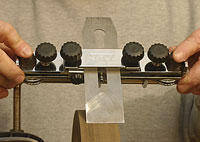 |
This JET jig makes a once guess-based sharpening task simple and predictable. Click image to enlarge |
JET PCJ-1 Camber Jig
Straight edges aren’t always right
Text & photos by Tom Hintz
Posted – 1-14-2007
Hand plane users have purposely ground slightly rounded cutting edges on their plane irons for a long time. This slight rounding of the edge, called camber, makes it easier to make line-free cuts. Generally, more camber is used for rough cuts than for finish work but the exact amount is a personal decision based on what feels best to you. The biggest problem with this sharpening technique has been consistently grinding a specific amount of camber. The JET PCJ-1 Plane Camber Jig makes this an easy, precise and repeatable task.
The Concept
The JET PCJ-1 Plane Camber Jig has a normal straight edge fixture built into a rocking table that can be adjusted very precisely on either end. This fine adjustment also makes repeating a specific camber setting as easy as counting the notches in the adjuster wheel. This accuracy also makes it easier to experiment with known amounts of camber to find what feels best in your work.
The JET PCJ-1 Plane Camber Jig has an adjustable fence that can be set to mark the position of an iron after it has been centered. This makes returning it to the exact position for resharpening fast and precise.
Setup
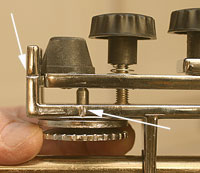 |
Notches and has marks make setting up and adjusting the JET Camber Jig very easy but more importantly, repeatable. Click image to enlarge |
The initial setup of the JET PCJ-1 Plane Camber Jig is easier than it looks. Install the iron in the clamp, making sure it is centered and square to the jig. I use a small (but precise) Woodpeckers Mini Square to be sure the iron is perfectly aligned with the jig. A set of hash marks cast into the mount make centering it as easy as putting the edges over the same mark on either side. Tighten the clamp bar down evenly.
Adjust the outboard camber dials until the rocking table is level in the jig, aligning its end with notches on either end JET PCJ-1 Plane Camber Jig body. Check to be sure the iron is actually flat against the stone and adjust the jig if necessary. Now, use the notches in the camber adjusting dials to set the amount of tilt on each side. The actual amount of camber developed by this setting varies with the width of the iron so it is a bit of a hunt initially. However, once you find a camber setting you like, counting these hash marks makes returning to it very easy.
Slide the JET PCJ-1 Plane Camber Jig onto the support arm (in the vertical mounts) and color the bevel with a marker. Adjust the support arm to match the existing bevel and confirm by holding the bevel against the stone and turning it by hand to make a scratch pattern in the coloring. For a new bevel setting, use the Angle Measuring Device set the new angle.
Grinding the Camber
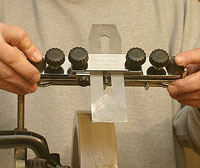 |
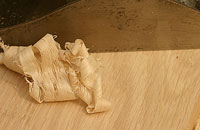 |
(top) Grinding camber is as easy as pushing down on the side of the jig that is over the stone. (bottom) Suddenly, my hand planes actually create smooth surfaces. I haven't gotten any better, the JET Camber Jig is the real secret. Click image to enlarge |
Before the JET PCJ-1 Plane Camber Jig, grinding camber into a plane iron was a matter of skill, timing and luck in varying proportions. The idea was to spend more time grinding on the edges of the iron than the middle.
With the JET PCJ-1 Plane Camber Jig, that guesswork is taken out of the equation. Full, even passes back and forth while rocking the table of the JET PCJ-1 Plane Camber Jig to the side on the stone. I found it helpful to stop occasionally and color the bevel again to gauge progress. After gaining a little familiarity with this sharpening process I only needed to color the bevel at the end to confirm that the entire bevel had been ground.
After using a flat stone to remove the burr raised by grinding the bevel, the JET PCJ-1 Plane Camber Jig can be moved to the leather honing wheel to finish dressing the bevel. Use the same sweeping motion while rocking the JET PCJ-1 Plane Camber Jig as the edges come onto the honing surface.
In the Shop
See It Work! |
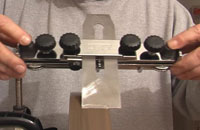 |
I will never bee mistaken for a hand plane aficionado but the JET PCJ-1 Plane Camber Jig made a large difference in the finish I was able to produce. Previously lines left in the surface plagued me by the plane, even though it was taking nice cuts. Approximately ten minutes of work with the JET PCJ-1 Plane Camber Jig all but eliminated those lines completely. My less than stellar (or practiced) technique with hand planes is certainly responsible for the lines that remain. However, they are far less noticeable than before and sand out quickly.
Conclusions
If you like camber in your planning irons, or have yet to try it, the JET PCJ-1 Plane Camber Jig will be a big help in getting it right in a minimal amount of time. The JET PCJ-1 Plane Camber Jig can be as helpful to infrequent hand plane users as it will be to hand tool veterans. Being able to grind a small but consistent amount of camber into my plane irons has made the hand plane more attractive for me in the shop. I now actually plane smooth surfaces that need very little sanding.
Pricing Link |
With a street price of $99.99 (1-12-2007) the JET PCJ-1 Plane Camber Jig could turn out to be a cheap way to save time, plane iron steel and your reputation as a kind, loving individual. The consistency and predictability of the JET PCJ-1 Plane Camber Jig has made my plane-related time in the shop far more enjoyable in part because I am no longer tempted to throw the plane at whomever appears at the door next.
Have a comment on this review? - Email Me!
All written, photographic and drawn materials are property of and copyright by NewWoodworker.com LLC 2000-2019. Materials may not be used in any way without the written permission of the owner.
